Unifying the Synthesis of a Whole Family of Marine Meroterpenoids through a Biosynthetically Inspired Sequence of 1,2-Hydride and Methyl Shifts as Key Step
Abstract
:1. Introduction
2. Synthesis of the Tetracyclic Alkenes 12a–d
2.1. George’s Synthesis of Compound 12a
2.2. Rosales Martínez’s Synthesis of Compound 12b
2.3. Wu´s Synthesis of Compound 12c
2.4. Li’s Synthesis of Compound 12b
3. Probable Reaction Mechanism for BF3·Et2O Mediated 1,2-Hydride and Methyl Shifts to Generate Aureane Compounds 12a–d
4. Future Perspectives
5. Conclusions
Author Contributions
Funding
Institutional Review Board Statement
Informed Consent Statement
Data Availability Statement
Acknowledgments
Conflicts of Interest
References
- Ueda, K.; Uemura, D. Studies in Natural Products Chemistry. Atta-ur-Rahman, Ed.; Elsevier: Amsterdam, The Netherlands, 2008; Volume 35, pp. 57–100. [Google Scholar]
- Marcos, I.S.; Conde, A.; Moro, R.F.; Basabe, P.; Diez, D.; Urones, J.G. Quinone/Hydroquinone Sesquiterpenes. Mini-Rev. Org. Chem. 2010, 7, 230–254. [Google Scholar] [CrossRef]
- Menna, M.; Imperatore, C.; D’Aniello, F.; Aiello, A. Meroterpenes from Marine Invertebrates: Structures, Occurrence, and Ecological Implications. Mar. Drugs 2013, 11, 1602–1643. [Google Scholar] [CrossRef] [PubMed]
- García, P.A.; Hernández, Á.P.; San Feliciano, A.; Castro, M.Á. Bioactive Prenyl-and Terpenyl-Quinones/Hydroquinones of Marine Origin. Mar. Drugs 2018, 16, 292. [Google Scholar] [PubMed]
- Taishi, T.; Takechi, S.; Mori, S. First total synthesis of (±)-stachyflin. Tetrahedron Lett. 1998, 39, 4347–4350. [Google Scholar] [CrossRef]
- Nakamura, M.; Suzuki, A.; Nakatani, M.; Fuchikami, T.; Inoue, M.; Katoh, T. An efficient synthesis of (+)-aureol via boron trifluoride etherate-promoted rearrangement of (+)-arenarol. Tetrahedron Lett. 2002, 43, 6929–6932. [Google Scholar] [CrossRef]
- Watanabe, K.; Sakurai, J.; Abe, H.; Katoh, T. Total synthesis of (+)-stachyflin: A potential anti-influenza A virus agent. Chem. Commun. 2010, 46, 4055–4057. [Google Scholar] [CrossRef] [PubMed]
- Marcos, I.S.; Conde, A.; Moro, R.F.; Basabe, P.; Díez, D.; Urones, J.G. Synthesis of quinone/hydroquinone sesquiterpenes. Tetrahedron 2010, 66, 8280–8290. [Google Scholar] [CrossRef]
- Sakurai, J.; Kikuchi, T.; Takahashi, O.; Watanabe, K.; Katoh, T. Enantioselective total synthesis of (+)-stachyflin: A potential anti-influenza A virus agent isolated from a microorganism. Eur. J. Org. Chem. 2011, 2011, 2948–2957. [Google Scholar] [CrossRef]
- Kuan, K.K.W.; Pepper, H.P.; Bloch, W.M.; George, J.H. Total synthesis of (+)-aureol. Org. Lett. 2012, 14, 4710–4713. [Google Scholar] [CrossRef]
- Kamishima, T.; Kikuchi, T.; Katoh, T. Total synthesis of (+)-strongylin A, a rearranged sesquiterpenoid hydroquinone from a marine sponge. Eur. J. Org. Chem. 2013, 2013, 4558–4563. [Google Scholar] [CrossRef]
- Rosales, A.; Muñoz-Bascón, J.; Roldan-Molina, E.; Rivas Bascón, N.; Padial, N.M.; Rodríguez-Maecker, R.; Rodríguez-García, I.; Oltra, J.E. Synthesis of (±)-aureol by bioinspired rearrangements. J. Org. Chem. 2015, 80, 1866–1870. [Google Scholar] [CrossRef] [PubMed]
- Katoh, T.; Atsumi, S.; Saito, R.; Narita, K.; Katoh, T. Unified synthesis of the marine sesquiterpene quinones (+)-smenospongine, (-)-ilimaquinone, (+)-smenospongine, and (+)-isospongiaquinone. Eur. J. Org. Chem. 2017, 2017, 3837–3849. [Google Scholar] [CrossRef]
- Wu, Y.; Du, X.; Wang, X.; Liu, H.; Zhou, L.; Tang, Y.; Li, D. Bio-inspired construction of a tetracyclic ring system with avarane skeleton: Total synthesis of dactyloquinone A. Org. Chem. Front. 2022, 9, 4705–4711. [Google Scholar] [CrossRef]
- Wildermuth, R.; Speck, K.; Haut, F.-L.; Mayer, P.; Karge, B.; Broenstrup, M.; Magauer, T. A modular synthesis of tetracyclic meroterpenoid antibiotics. Nat. Commun. 2017, 8, 1–9. [Google Scholar] [CrossRef] [PubMed]
- George, J.H.; McArdle, M.; Baldwin, J.E.; Adlington, R.M. Biomimetic rearrangements of simplified labdane diterpenoids. Tetrahedron 2010, 66, 6321–6330. [Google Scholar] [CrossRef]
- Hugelshofera, C.L.; Magauer, T. Dyotropic rearrangements in natural products synthesis and biosynthesis. Nat. Prod. Rep. 2017, 34, 228–234. [Google Scholar] [CrossRef]
- George, J.H. Biomimetic dearomatization strategies in the total synthesis of meroterpenoid natural products. Acc. Chem. Res. 2021, 54, 1843–1855. [Google Scholar] [CrossRef]
- Beaudry, C.M.; Malerich, J.P.; Trauner, D. Biosynthetic and Biomimetic Electrocyclizations. Chem. Rev. 2005, 105, 4757–4778. [Google Scholar] [CrossRef]
- Wang, J.-L.; Li, H.-J.; Wang, M.; Wang, J.-H.; Wu, Y.-C. A six-step synthetic approach to marine natural product (+)-aureol. Tetrahedron Lett. 2018, 59, 945–948. [Google Scholar] [CrossRef]
- Rosales Martínez, A.; Enríquez, L.; Jaraíz, M.; Pozo Morales, L.; Rodríguez-García, I.; Díaz Ojeda, E. A Concise Route for the Synthesis of Tetracyclic Meroterpenoids: (±)-Aureol Preparation and Mechanistic Interpretation. Mar. Drugs 2020, 18, 441. [Google Scholar] [CrossRef]
- Rojas, C.M. Molecular Rearrangements in Organic Synthesis; John Wiley & Sons: Hoboken, NJ, USA, 2015. [Google Scholar]
- Chen, L.; Li, G.; Zu, L. Natural product total synthesis using rearrangement reactions. Org. Chem. Front. 2022, 9, 5383–5394. [Google Scholar] [CrossRef]
- Zhang, X.; Tu, Y.; Zhang, F.; Chen, Z.; Wang, S. Recent applications of the 1,2-carbon atom migration strategy in complex natural product total synthesis. Chem. Soc. Rev. 2017, 46, 2272–2305. [Google Scholar] [CrossRef] [PubMed]
- Delayre, B.; Wang, Q.; Zhu, J. Natural Product Synthesis Enabled by Domino Processes Incorporating a 1,2-Rearrangement Step. ACS Cent. Sci. 2021, 7, 559–569. [Google Scholar] [CrossRef] [PubMed]
- Djura, P.; Stierle, D.B.; Sullivan, B.; Faulkner, D.J.; Arnold, E.; Clardy, J. Some metabolites of the marine sponges Smenospongia aurea and Smenospongia (polyfibrospongia) echina. J. Org. Chem. 1980, 45, 1435–1441. [Google Scholar] [CrossRef]
- Wright, A.E.; Cross, S.S.; Burres, N.S.; Koehn, F. Novel Antiviral and Antitumor Terpene Hydroquinones and Methods of Use. PCT WO 9112250A1, 22 August 1991. [Google Scholar]
- Longley, R.E.; McConnell, O.J.; Essich, E.; Harmody, D.J. Evaluation of Marine Sponge Metabolites for Cytotoxicity and Signal Transduction Activity. Nat. Prod. 1993, 56, 915–920. [Google Scholar] [CrossRef] [PubMed]
- Chhetri, B.K.; Tedbury, P.R.; Sweeney-Jones, A.M.; Mani, L.; Soapi, K. Marine Natural Products as Leads against SARS-CoV-2 Infection. J. Nat. Prod. 2022, 85, 657–665. [Google Scholar] [CrossRef]
- Rosales, A.; López-Sánchez, C.; Álvarez-Corral, M.; Muñoz-Dorado, M.; Rodríguez-García, I. Total Synthesis of (±)-Euryfuran Through Ti(III) Catalyzed Radical Cyclization. Lett. Org. Chem. 2007, 4, 553–555. [Google Scholar] [CrossRef]
- Rosales, A.; Muñoz-Bascón, J.; Moráles-Álcazar, V.M.; Castilla-Alcalá, J.A.; Oltra, J.E. Ti(III)-catalyzed, concise synthesis of marine furanospongian diterpenes. RSC Adv. 2012, 2, 12922–12925. [Google Scholar] [CrossRef]
- Rosales, A.; Muñoz-Bascón, J.; López-Sánchez, C.; Álvarez-Corral, M.; Muñoz-Dorado, M.; Rodríguez-García, I.; Oltra, J.E. Ti-Catalyzed Homolytic Opening of Ozonides: A sustainable C-C Bond-Forming Reaction. J. Org. Chem. 2012, 77, 4171–4176. [Google Scholar] [CrossRef]
- Rosales, A.; Foley, L.A.R.; Padial, N.M.; Muñoz-Bascón, J.; Sancho-Sanz, I.; Roldán-Molina, E.; Pozo-Morales, L.; Irías-Álvarez, A.; Rodríguez-Maecker, R.; Rodríguez-García, I.; et al. Diastereoselective Synthesis of (±)-ambroz by Titanium(III)-Catalyzed Radical Tandem Cyclization. Synlett 2016, 27, 369–374. [Google Scholar] [CrossRef]
- Rosales Martinez, A.; Pozo Morales, L.; Diaz Ojeda, E. Cp2TiCl-catalyzed, concise synthetic approach to marine natural product (±)-cyclozonarone. Synth. Commun. 2019, 49, 2554–2560. [Google Scholar] [CrossRef]
- Rosales Martínez, A.; Pozo Morales, L.; Díaz Ojeda, E.; Castro Rodríguez, M.; Rodríguez-García, I. The Proven Versatility of Cp2TiCl. J. Org. Chem. 2021, 86, 1311–1329. [Google Scholar] [CrossRef] [PubMed]
- Rosales Martínez, A.; Rodríguez-García, I.; López-Martínez, J. Divergent Strategy in Marine Tetracyclic Meroterpenoids. Mar. Drugs 2021, 19, 273. [Google Scholar] [CrossRef] [PubMed]
- Gansäuer, A.; Rosales, A.; Justicia, J. Catalytic epoxypolyene cyclization via radicals: Highly diastereoselective formal synthesis of puupehedione and 8-epi-puupehedione. Synlett 2006, 6, 927–929. [Google Scholar] [CrossRef]
- Gansäuer, A.; Justicia, J.; Rosales, A.; Worgull, B.; Rinker, B.; Cuerva, J.M.; Oltra, J.E. Transition-Metal-Catalyzed Allylic Substitution and Titanocene-Catalyzed Epoxypolyene Cyclization as a Powerful Tool for the Preparation of Terpenoids. Eur. J. Org. Chem. 2006, 2006, 4115–4127. [Google Scholar] [CrossRef]
- Castro Rodríguez, M.; Rodríguez García, I.; Rodríguez Maecker, R.N.; Pozo Morales, L.; Oltra, J.E.; Rosales Martínez, A. Cp2TiCl: An Ideal Reagent for Green Chemistry? Org. Process Res. Dev. 2017, 21, 911–923. [Google Scholar] [CrossRef]
- Rosales Martínez, A.; Castro Rodríguez, M.; Rodríguez-García, I.; Pozo Morales, L.; Rodríguez Maecker, R.N. Titanocene dichloride: A new green reagent in organic chemistry. Chin. J. Catal. 2017, 38, 1659–1663. [Google Scholar] [CrossRef]
- Barrero, A.F.; Herrador, M.M.; del Moral, J.F.Q.; Arteaga, P.; Arteaga, J.F.; Piedra, M.; Sánchez, E.M. Reductive Coupling of Terpenic Allylic Halides Catalyzed by Cp2TiCl: A Short and Efficient Asymetric Synthesis of Onocerane Triterpenes. Org. Lett. 2005, 7, 2301–2304. [Google Scholar] [CrossRef]
- Minagawa, K.; Kouzuki, S.; Yoshimoto, J.; Kawamura, Y.; Tani, H.; Iwata, T.; Terui, Y.; Nakai, H.; Yagi, S.; Hattori, N.; et al. Stachyflin and acetylstachyflin, novel anti-influenza a virus substances, produced by Stachybotrys sp. RF-7260. J. Antibiot. 2002, 55, 155–164. [Google Scholar] [CrossRef]
- Concepción, J.I.; Francisco, C.G.; Freire, R.; Hernández, R.; Salazar, J.A.; Suárez, E. Iodosobenzene Diacetate, an Efficient Reagent for the Oxidative Decarboxylation of Carboxylic Acids. J. Org. Chem. 1986, 51, 402–404. [Google Scholar] [CrossRef]
- Mitome, H.; Nagasawa, T.; Miyaoka, H.; Yamada, Y.; van Soest, R.W.M. New Sesquiterpenoid Quinones from the Okinawan Marine Sponge Dactylospongiaelegans. J. Nat. Prod. 2001, 64, 1506–1508. [Google Scholar] [CrossRef] [PubMed]
- Urban, S.; Capon, R.J. Marine Sesquiterpene Quinones and Hydroquinones: Acid-Catalyzed Rearrangements and Stereochemical Investigations. Aust. J. Chem. 1994, 47, 1023–1029. [Google Scholar] [CrossRef]
- Capon, R.J. The Acid-Catalyzed Rearrangement and Absolute Stereochemistry of Isospongiaquinone. J. Nat. Prod. 1990, 53, 753–756. [Google Scholar] [CrossRef]
- Carraher, C.E., Jr. Ionic Chain-Reaction and Complex Coordinative Polymerization (Addition Polymerization). In Polymer Chemistry, 6th ed.; Marcel Dekker: New York, NY, USA, 2003. [Google Scholar]
- Utkina, N.K.; Denisenko, V.A.; Scholokova, O.V.; Virovaya, M.V.; Prokof’eva, N.G. Cyclosmenospongine, a new sesquiterpenoid aminoquinone from an Australian marine sponge Spongia sp. Tetrahedron Lett. 2003, 44, 101–102. [Google Scholar] [CrossRef]
- Speck, K.; Wildermuth, R.; Magauer, T. The Acid-Catalyzed Rearrangement and Absolute Stereochemistry of Isospongiaquinone. Angew. Chem. Int. Ed. 2016, 55, 14131–14135. [Google Scholar] [CrossRef] [PubMed]
- Speck, K.; Magauer, T. Evolution of a Polyene Cyclization Cascade for the Total Synthesis of (-)-Cyclosmenospongine. Chem. Eur. J. 2017, 23, 1157–1165. [Google Scholar] [CrossRef]
- Minagawa, K.; Kouzuki, S.; Kamigauchi, T. Stachyflin and acetylstachyflin, novel anti-influenza A virus substances, produced by Stachybotrys sp. RE-7260. II. Synthesis and Preliminary Structure-Activity Relationships of Stachyflin Derivatives. J. Antibiot. 2002, 55, 165–171. [Google Scholar] [CrossRef]
- Kamigauchi, T.; Fujiwara, T.; Tani, H.; Kawamura, Y.; Horibe, I. Sesquiterpene Derivatives Having Antiviral Activity. PCT WO 9711947 A1, 3 April 1997. [Google Scholar]
- Matthias Göhl, M.; Seifert, K. Synthesis of the Sesquiterpenes Albicanol, Drimanol, and Drimanic Acid, and the Marine Sesquiterpene Hydroquinone Deoxyspongiaquinol. Eur. J. Org. Chem. 2014, 2014, 6975–6982. [Google Scholar] [CrossRef]
- Wright, A.E.; Rueth, S.A.; Cross, S.S. An Antiviral Sesquiterpene Hydroquinone from the Marine Sponge Strongylophora hartmani. J. Nat. Prod. 1991, 54, 1108–1111. [Google Scholar] [CrossRef]
- Coval, S.J.; Conover, M.A.; Mierzwa, R.; King, A.; Puar, M.S.; Phife, D.W.; Pai, J.-K.; Burrier, R.E.; Ahn, H.-S.; Boykow, G.C.; et al. Wiedendiol-A and -B, chlolesteryl ester transfer protein inhibitors from the marine sponge Xestospongia wiedenmayeri. Bioorg. Med. Chem. Lett. 1995, 5, 605–610. [Google Scholar] [CrossRef]
- Yong, K.W.L.; Jankam, A.; Hooper, J.N.A.; Suksamrarn, A.; Garson, M.J. Stereochemical evaluation of sesquiterpene quinones from two sponges of the genus Dactylospongia and the implication for enantioselective processes in marine terpene biosynthesis. Tetrahedron 2008, 64, 6341–6348. [Google Scholar] [CrossRef]
- Prokof'eva, N.G.; Utkina, N.K.; Chaikina, E.L.; Makarchenko, A.E. Biological activities of marine sesquiterpenoid quinones: Structure-activity relationships in cytotoxic and hemolytic assays. Comp. Biochem. Physiol. Part B Biochem. Mol. Biol. 2004, 139B, 169–173. [Google Scholar] [CrossRef] [PubMed]
- Utkina, N.K.; Makarchenko, A.E.; Shchelokova, O.V.; Virovaya, M.V. Antioxidant activity of phenolic metabolites from marine sponges. Chem. Nat. Compd. 2004, 40, 373–377. [Google Scholar] [CrossRef]
- Bourguet-Kondracki, M.-L.; Martin, M.-T.; Guyot, M. Smenoqualone, a Novel Sesquiterpenoid from the Marine Sponge Smenospongia sp. Tetrahedron Lett. 1992, 33, 8079–8080. [Google Scholar] [CrossRef]
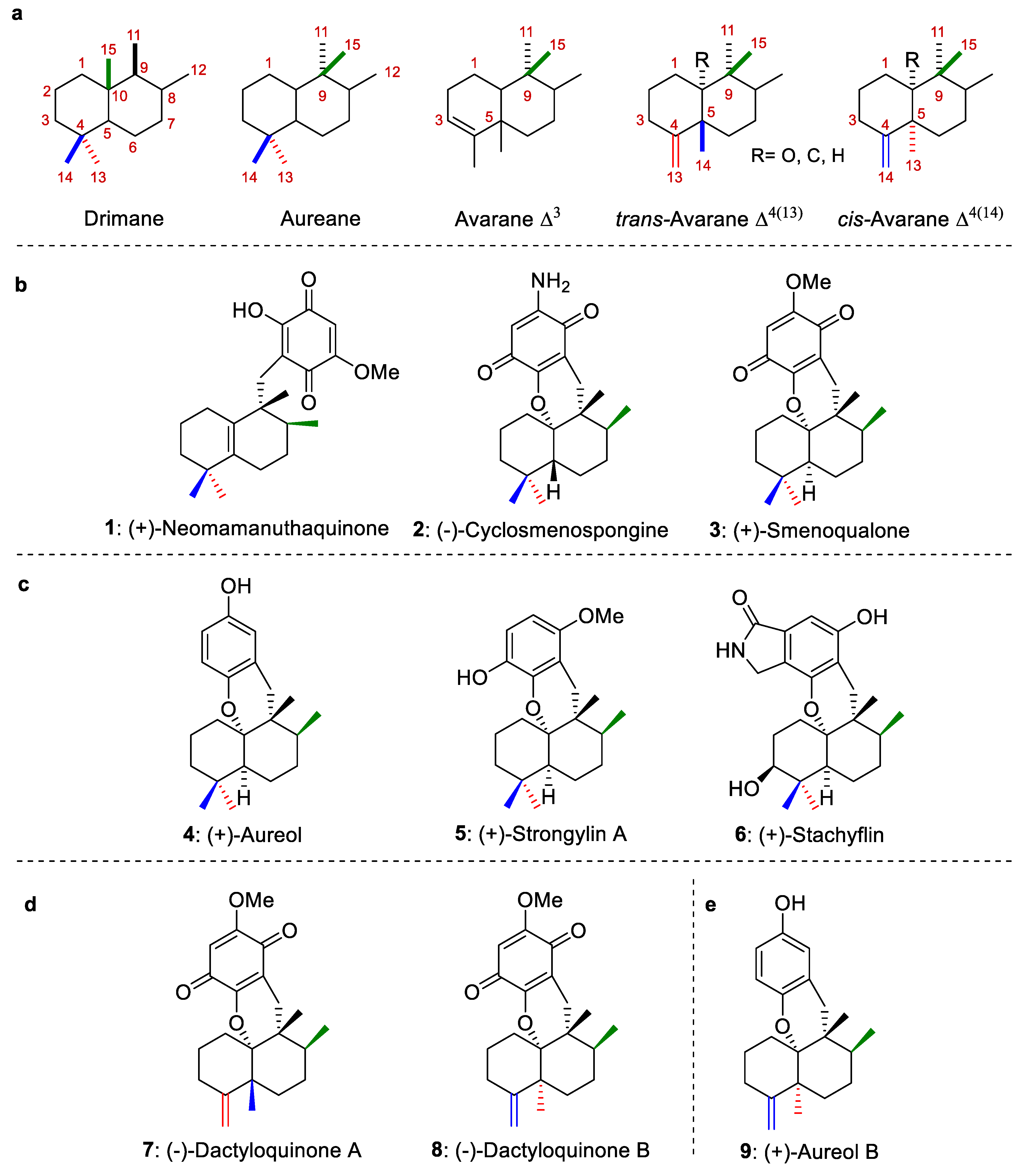
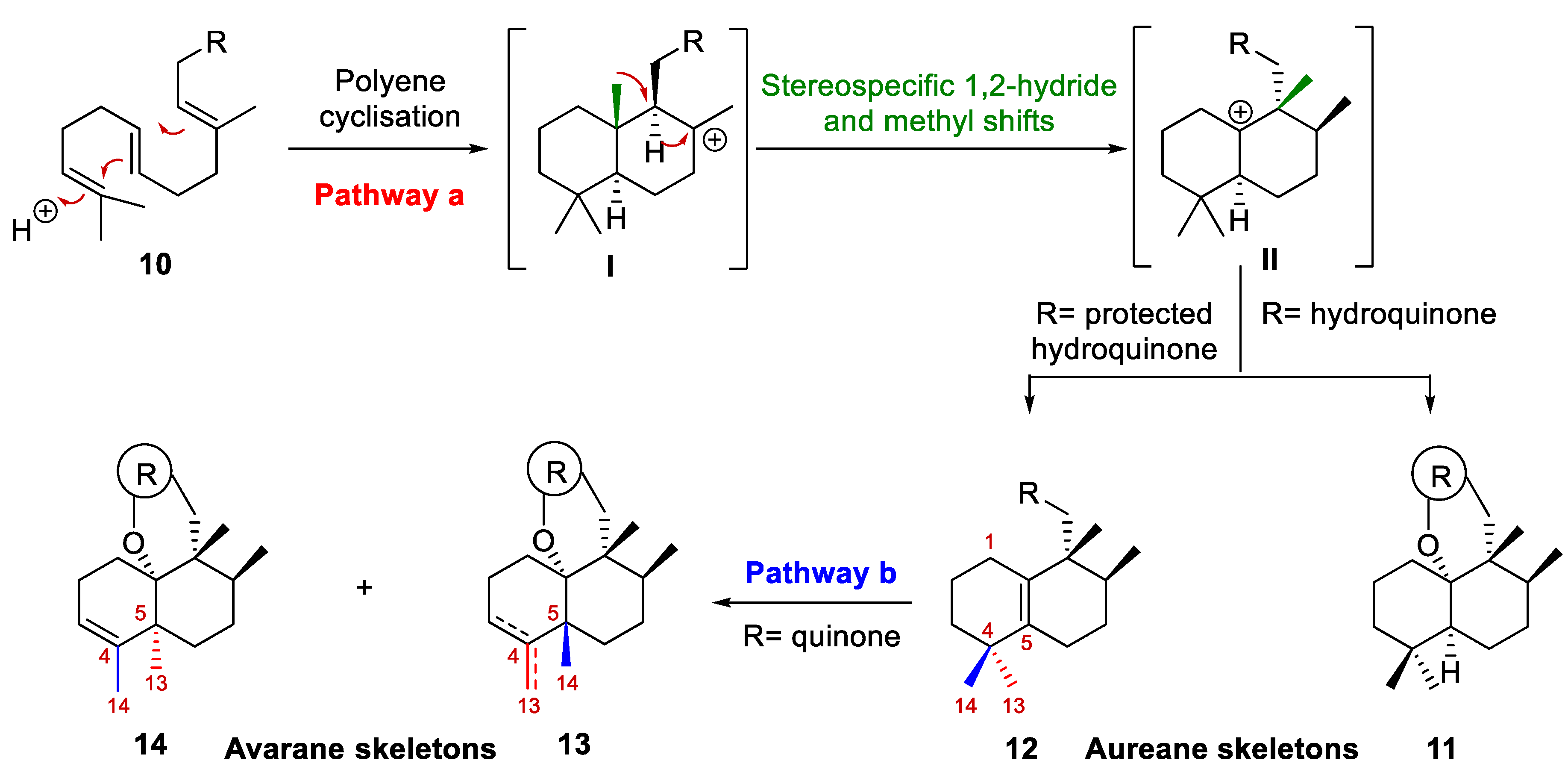

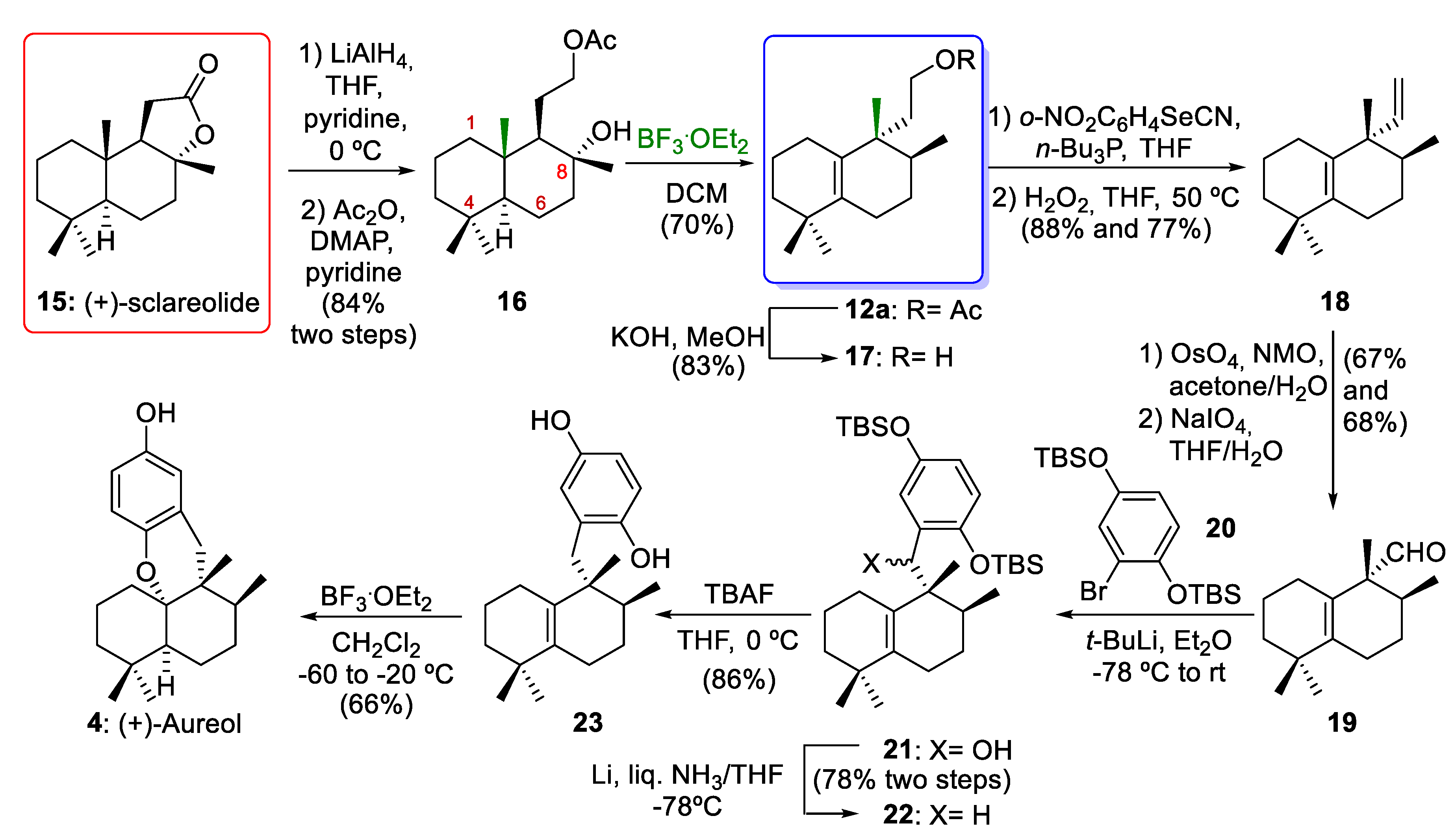

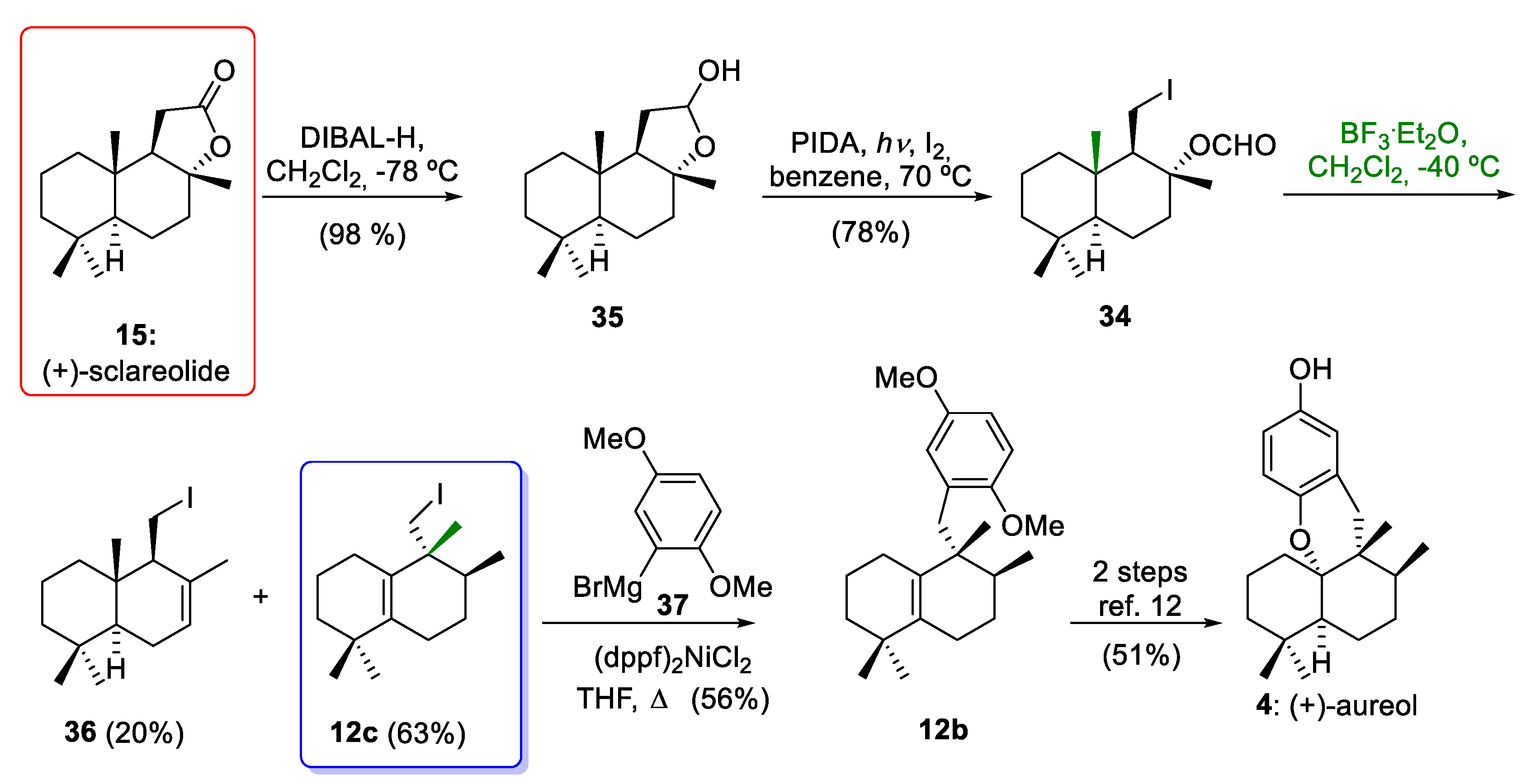
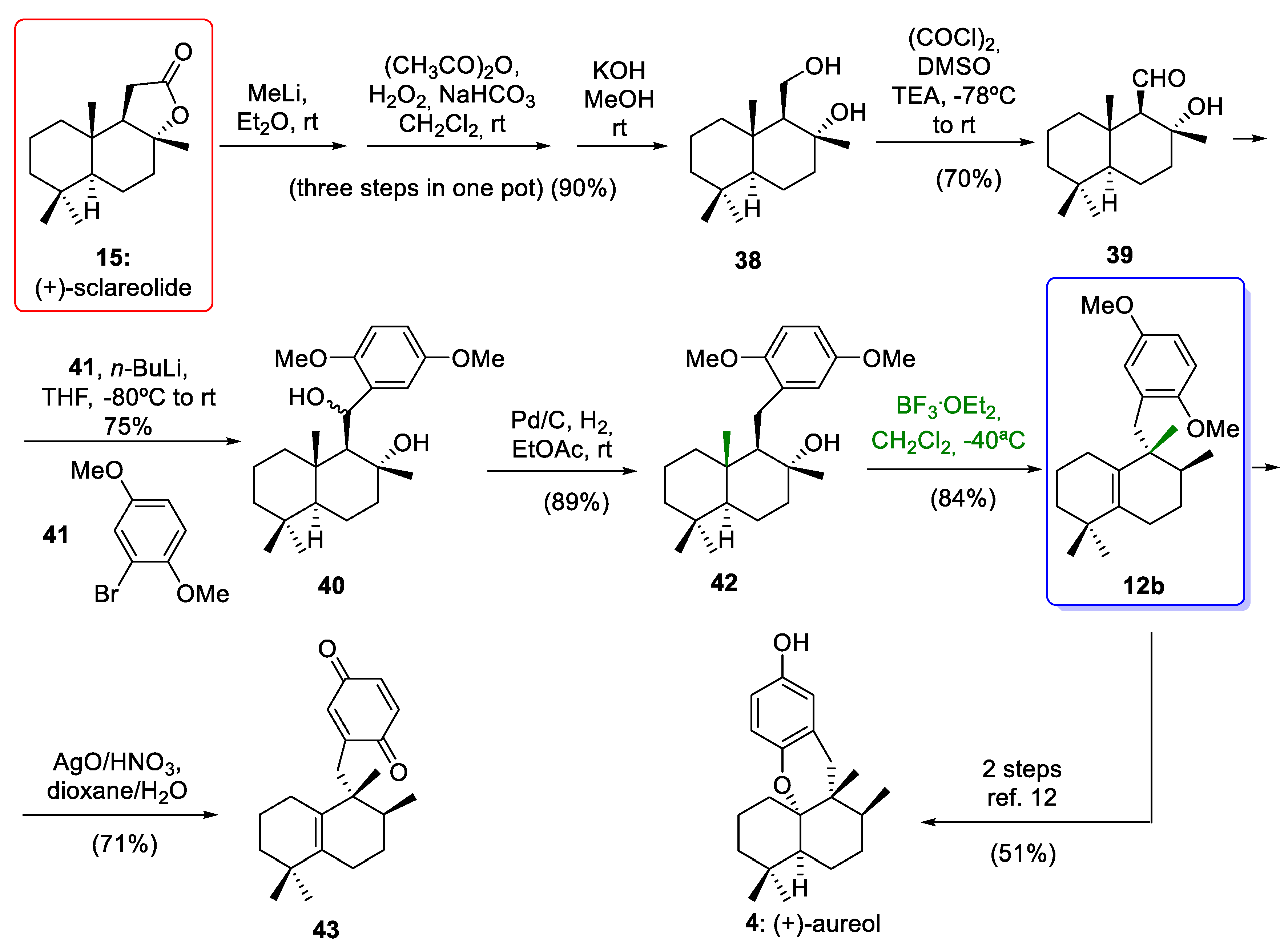
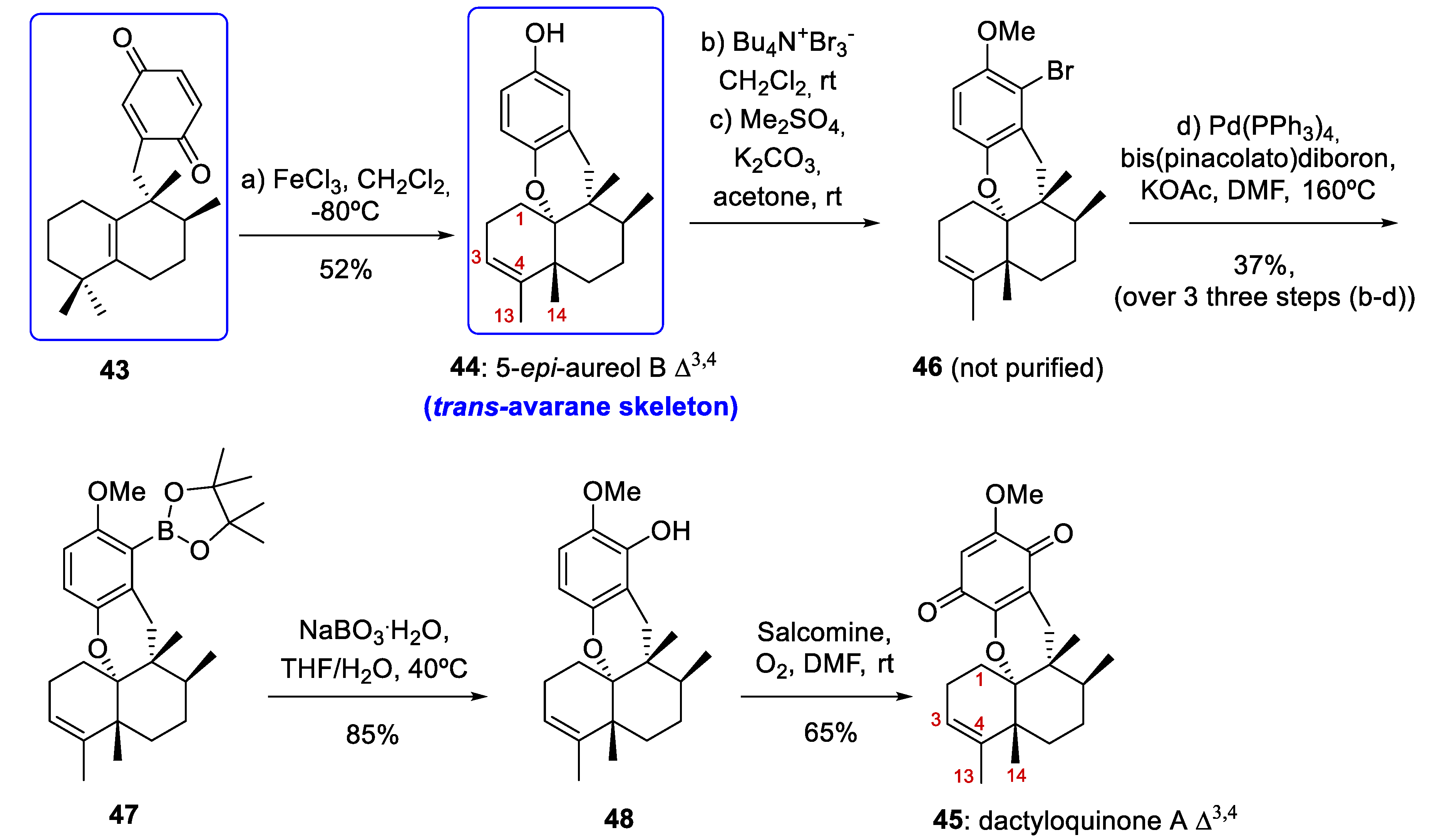


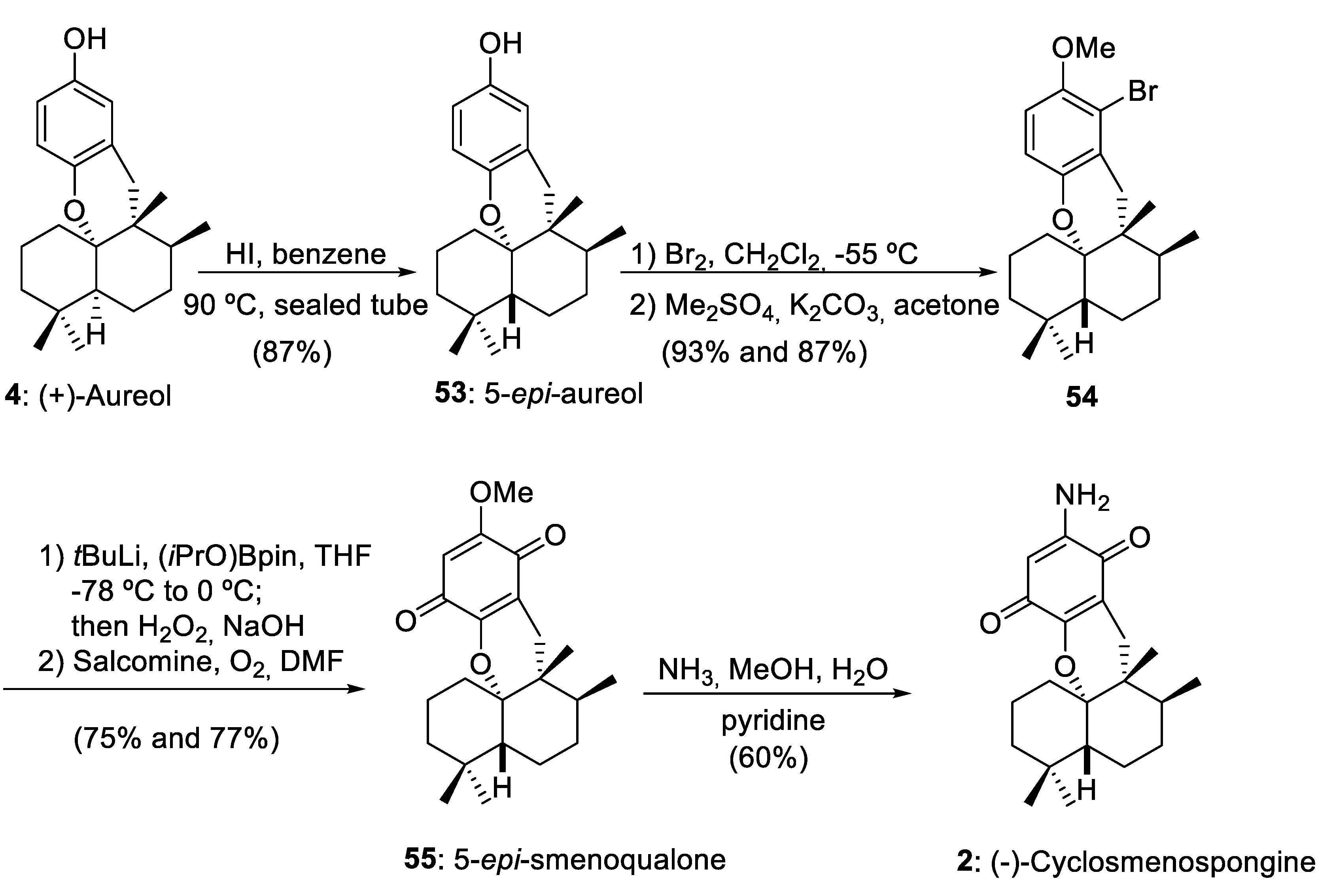



Disclaimer/Publisher’s Note: The statements, opinions and data contained in all publications are solely those of the individual author(s) and contributor(s) and not of MDPI and/or the editor(s). MDPI and/or the editor(s) disclaim responsibility for any injury to people or property resulting from any ideas, methods, instructions or products referred to in the content. |
© 2023 by the authors. Licensee MDPI, Basel, Switzerland. This article is an open access article distributed under the terms and conditions of the Creative Commons Attribution (CC BY) license (https://creativecommons.org/licenses/by/4.0/).
Share and Cite
Rosales Martínez, A.; Rodríguez-Maecker, R.N.; Rodríguez-García, I. Unifying the Synthesis of a Whole Family of Marine Meroterpenoids through a Biosynthetically Inspired Sequence of 1,2-Hydride and Methyl Shifts as Key Step. Mar. Drugs 2023, 21, 118. https://doi.org/10.3390/md21020118
Rosales Martínez A, Rodríguez-Maecker RN, Rodríguez-García I. Unifying the Synthesis of a Whole Family of Marine Meroterpenoids through a Biosynthetically Inspired Sequence of 1,2-Hydride and Methyl Shifts as Key Step. Marine Drugs. 2023; 21(2):118. https://doi.org/10.3390/md21020118
Chicago/Turabian StyleRosales Martínez, Antonio, Román Nicolay Rodríguez-Maecker, and Ignacio Rodríguez-García. 2023. "Unifying the Synthesis of a Whole Family of Marine Meroterpenoids through a Biosynthetically Inspired Sequence of 1,2-Hydride and Methyl Shifts as Key Step" Marine Drugs 21, no. 2: 118. https://doi.org/10.3390/md21020118
APA StyleRosales Martínez, A., Rodríguez-Maecker, R. N., & Rodríguez-García, I. (2023). Unifying the Synthesis of a Whole Family of Marine Meroterpenoids through a Biosynthetically Inspired Sequence of 1,2-Hydride and Methyl Shifts as Key Step. Marine Drugs, 21(2), 118. https://doi.org/10.3390/md21020118







